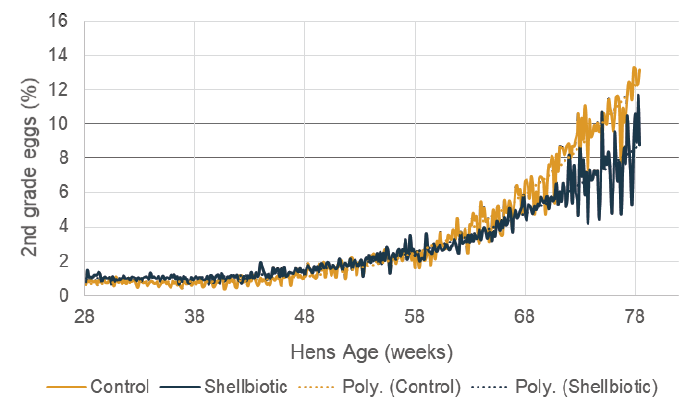With prolonged egg production cycles up to 100 weeks of age, maintaining egg quality, especially during the 2nd part of the production cycle, is a growing concern. Addressing this issue requires a deep understanding of the hen’s physiology and a multifactorial approach. Shellbiotic provides a unique mixture of Medium Chain Fatty Acids (MCFAs) improving egg production and egg quality.
Physiological background: the fragile balance between egg quantity and egg quality
The chicken egg is a nutritionally balanced source of nutrients that is of great interest in human diets across the globe. The manufacture of this essential product relies on meticulous physiological processes orchestrated by the domestic hen’s reproductive system.
Between 16 and 20 weeks of age, the hen undergoes hormonal changes resulting in a rapid development of its reproductive organs. The pituitary gland plays a major role by producing gonadotropins that stimulate the expansion of the left ovary and follicle development. In return, developing follicles stimulate the maturation of the oviduct through the secretion of estrogen and progesterone. This coordinated development of two key organs for egg production – the ovary and the oviduct – allows domestic hens to start their egg production cycle.
Egg production is thereafter controlled by the ovary and the oviduct in a complementary manner. On one hand, yolk components are produced by the liver under the control of estrogens primarily deriving from the ovary. Their accumulation in pre-ovulatory follicles before ovulation is a long term process (of more than a week). The intensity of egg production is directly related to the number of yolks produced and to their ovulation. This trait can therefore be attributed to the ovary. On the other hand, the oviduct ensures the secretion of the albumen and the eggshell in a short term process between ovulation and oviposition (about 22-23 hours). As a result, the latter organ sets most of the qualitative traits of the albumen and the eggshell.
Nowadays, one of the global trends infused by genetic companies is the improvement of the persistency of lay to reduce the environmental impact of the industry and increase its profitability. However, prolonging laying cycles up to 100 weeks of age to reach 500 eggs per hen housed increases the risk of oviduct malfunction and the sensibility to osteoporosis. In this context, maintaining the right balance between egg laying persistency and eggs qualitative traits is key.
Maintaining egg quality with Shellbiotic
Egg composition varies with age. Yolk weight increases as hens age, while shell and albumen weights remain equal causing a decrease of the relative percentage of shell material and more fragile eggshells. Simultaneously, a higher incidence of defective eggs is common at the end of the cycles even reaching up to 20%. The economic impact of such changes in egg quality still represents a major hurdle to overcome for prolonged egg laying cycles. Moreover, preserving egg quality is also critical to protect ensure consumers health and limit their exposure to pathogens.
Several factors can alter egg quality apart from mineral nutrition, including age, breed, animal health, the housing system or functional ingredients. For instance, proteins play an important role in determining egg quality. Ovomucins confer viscous properties to the albumen whereas shell-specific matrix proteins (like ovocleidins and ovocalyxins) give eggshells texture and improve their mechanical properties. Shellbiotic is a combination of MCFAs and lactic acid developed by Agrimprove to support the animal immune system based on an extensive knowledge of antibacterial and anti-inflammatory effects of these ingredients. In addition to enhancing gut health and intestinal morphology in the proximal section of the gastrointestinal tract (GIT), Shellbiotic also contributes to maintaining an optimal gizzard pH, which favors protein digestibility and minerals solubilization to nourish the oviduct.

By improving hen day production, the quality of eggs, egg weight and by reducing mortality (Table 1), Shellbiotic results in an increased total number of eggs per hen housed. Field data (Figure 1) indicate that, compared to a control group, Shellbiotic reduced the number of second grade eggs by 4% at 78 weeks of age and is thus able to support egg quality as hens age. Overall, by supporting the hen’s physiology, Shellbiotic improves egg laying performance and maintains egg quality after the production peak.
